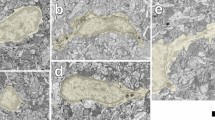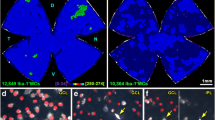Summary
We have studied the distribution of microglia in normalXenopus tadpoles and after an optic nerve lesion, using a monoclonal antibody (5F4) raised againstXenopus retinas of which the optic nerves had been cut 10 days previously. The antibody 5F4 selectively recognizes macrophages and microglia inXenopus. In normal animals microglia are sparsely but widely distributed throughout the retina, optic nerve, diencephalon and mesencephalon (other regions were not examined). After crush or cut of an optic nerve, or eye removal, there occurs an extensive microglial response along the affected optic pathway. Within 18 h an increase in the number of microglial cells in the optic tract and tectum can be detected. This response increases to peak at around 5 days after the lesion. At this time the nerve distal to the lesion contains many microglial cells; the entire optic tract is outlined by microglia, extended along the degenerating fibres; and the affected tectum shows a heavy concentration of microglia. This microglial response thereafter decreases and has mostly gone by 34 days. We conclude that the microglial response to optic nerve injury inXenopus tadpoles starts early, peaks just before the regenerating optic nerve axons enter the brain, and is much diminished by the time the retinotectal projection is re-established. The timing is such that the microglial response could play a major role in facilitating regeneration.
Similar content being viewed by others
References
Bignami A, Dahl D, Nguyen BT, Crosby CJ (1981) The fate of axonal debris in Wallerian degeneration of rat optic and sciatic nerves. J Neuropath Exp Neurol 40:537–550
Caroni P, Schwab ME (1988) Two membrane protein fractions from rat central myelin with inhibitory properties for neurite growth and fibroblast spreading. J Cell Biol 106:1281–1288
Carter DA, Bray GM, Aguayo AJ (1989) Regenerated retinal ganglion cell axons can form well-differentiated synapses in the superior colliculus of adult hamsters. J Neurosci 9:4042–4050
Cowan WM, Hunt RK (1985) The development of the retinotectal projection: an overview. In: Edelman GM, Gall WE, Cowan WM (eds) Molecular bases of neural development. Wiley, New York, pp 389–428
Easter SS Jr, Stuermer CAO (1984) An evaluation of the hypothesis of shifting terminals in goldfish optic tectum. J Neurosci 4:1052–1063
Gaze RM, Grant P (1978) The diencephalic course of regenerating retinotectal fibres inXenopus tadpoles. J Embryol Exp Morphol 44:201–216
Gaze RM, Keating MJ, Chung SH (1974) The evolution of the retinotectal map during development inXenopus. Proc R Soc Lond [Biol] 185:301–330
Gaze RM, Wilson MA, Taylor JSH (1990) Regeneration of optic fibres through the chiasma inXenopus laevis tadpoles. Anat Embryol 182:181–194
Goodbrand IA (1991) The microglial response to optic nerve injury inXenopus. J Physiol (Lond) 434:56p
Gordon S (1986) Biology of the Macrophage. J Cell Sci [Suppl 4]:267–286
Hume DA, Perry VH, Gordon S (1983) Immunohistochemical localization of a macrophage-specific antigen in developing mouse retina: phagocytosis of dying axons and differentiation of microglial cells to form a regular array in the plexiform layers. J Cell Biol 97:253–257
Innocenti GM, Clarke S, Koppel H (1983) Transitory macrophages in the white matter of the developing visual cortex. II. Development and relations with axonal pathways. Dev Brain Res 11:55–66
Jenkins S, Straznicky C (1986) Naturally occurring and induced ganglion cell death: a retinal whole-mount autoradiographic study inXenopus. Anat Embryol 174:59–66
Kierstead SA, Rasminski M, Fukuda Y, Carter DA, Aguayo AJ, Vidal-Sanz M (1989) Electrophysiologic responses in Hamster superior colliculus evoked by regenerating retinal axons. Science 246:255–257
Kohler G, Milstein C (1975) Continuous cultures of fused cells secreting antibody of predefined specificity. Nature 256:495–497
Lázár G (1979) Elimination of cobalt from the frog brain introduced into the optic centres through the optic nerve. Acta Biol Acad Sci Hung 30:245–255
Nieuwkoop PD, Faber J (1967) Normal Table ofXenopus laevis (Daudin). North Holland, Amsterdam
Perry VH, Gordon S (1989) Resident macrophages of the central nervous system: modulation of phenotype in relation to a specialized microenvironment. In: Goetzl EJ (ed) Neuroimmune networks: physiology and diseases. Liss, New York, pp 119–125
Perry VH, Gordon S (1991) Macrophages and the nervous system. Int Rev Cytol 125:203–244
Perry VH, Hume DA, Gordon S (1985) Immunohistochemical localization of macrophages and microglia in the adult and developing mouse brain. Neuroscience 15:313–326
Perry VH, Brown MC, Gordon S (1987) The macrophage response to central and peripheral nerve injury. J Exp Med 165:1218–1223
Phillips LL, Turner JE (1991) Biphasic cellular response to transection in the newt optic nerve: glial reactivity precedes axonal degeneration. J Neurocytol 20:51–64
Pow DV, Perry VH, Morris JF, Gordon S (1989) Microglia in the neurohypophysis associate with and endocytose terminal portions of neurosecretory neurons. Neuroscience 33:567–578
Reh TA, Constantine-Paton M (1984) Retinal ganglion cell terminals change their projection sites during larval development ofRana pipiens. J Neurosci 4:442–457
Reier PJ, Webster H deF (1974) Regeneration and remyelination ofXenopus tadpole optic nerve fibres following transection or crush. J Neurocytol 3:591–618
del Rio-Hortega P (1932) Microglia. In: Penfield W (ed) Cytology and cellular pathology of the nervous system. Hoeber, New York, pp 483–534
Schmidt JT (1982) The formation of retinotectal projections. Trends Neurosci 5:111–116
Schnell L, Schwab ME (1990) Axonal regeneration in the rat spinal cord produced by an antibody against myelin-associated neurite growth inhibitors. Nature 343:269–272
Schulman M, Wilde CD, Kohler G (1978) A better cell line for making hybridomas and creating specific antibodies. Nature 276:269–270
Schnitzer J (1989) Enzyme-histochemical demonstration of microglial cells in the adult and postnatal rabbit retina. J Comp Neurol 282:249–263
Schwab ME, Caroni P (1988) Oligodendrocytes and CNS myelin are nonpermissive substrates for neurite growth and fibroblast spreading in vitro. J Neurosci 8:2381–2393
Springer AD, Wilson BR (1989) Light microscopic study of degnerating cobalt-filled optic axons in goldfish: role of microglia and radial glia in debris removal. J Comp Neurol 282:119–132
Stoll G, Trapp BD, Griffin JW (1989) Macrophage function during Wallerian degeneration of rat optic nerve: clearance of degenerating myelin and 1a expression. J Neurosci 9:2327–2335
Straznicky K, Gaze RM (1972) The development of the tectum inXenopus laevis: an autoradiographic study. J Embryol Exp Morphol 28:87–115
Streit WJ, Kreutzberg GW (1987) Lectin binding by resting and reactive microglia. J Neurocytol 16:249–260
Taylor JSH, Gaze RM (1990) The induction of an anomalous ipsilateral retinotectal projection ofXenopus laevis. Anat Embryol 181:393–404
Turner JE, Glaze KA (1977) The early stages of Wallerian degeneration in the severed optic nerve of the newt (Triturus viridescens). Anat Rec 187:291–310
Turner JE, Singer M (1975) The ultrastructure of Wallerian degeneration in the severed optic nerve of the Newt (Triturus viridescens). Anat Rec 181:267–286
Vidal-Sanz M, Bray GM, Villegas-Perez MP, Thanos S, Aguayo AJ (1987) Axonal regeneration and synapse formation in the superior colliculus by retinal ganglion cells in the adult rat. J Neurosci 7:2894–2909
Wilson MA, Taylor JSH, Gaze RM (1988) A developmental and ultrastructural study on the optic chiasma inXenopus. Development 102:537–553
Author information
Authors and Affiliations
Rights and permissions
About this article
Cite this article
Goodbrand, I.A., Gaze, R.M. Microglia in tadpoles ofXenopus laevis: Normal distribution and the response to optic nerve injury. Anat Embryol 184, 71–82 (1991). https://doi.org/10.1007/BF01744263
Accepted:
Issue Date:
DOI: https://doi.org/10.1007/BF01744263




